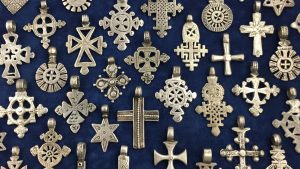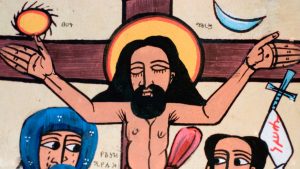
Get Up to 15% OFF Store wide – Limited time only
Menu
Get Up to 15% OFF Store wide – Limited time only

Ethiopian art is a rich tapestry of cultural narratives, spiritual symbolism, and ancestral traditions. Every brushstroke, carving, and textile holds meaning, crafted not only for beauty but to serve as powerful vessels of Ethiopian history, beliefs, and values. Ethiopian artists have long used their work to tell stories, convey cultural pride, and delve into life’s deeper mysteries. Today, Ethiopian art invites viewers not only to appreciate its visual appeal but also to explore the layers of meaning that transcend the canvas, each symbol a testament to Ethiopian identity and resilience.
In Ethiopian art, spirituality and cultural identity are deeply intertwined. From religious icons and illuminated manuscripts to Ethiopian crosses and woven textiles, each piece tells a story. Aida Fekadu, an art historian, explains, “Ethiopian art is more than an expression of culture; it’s a reflection of a belief system spanning centuries. Symbols in Ethiopian art represent resilience, faith, and an enduring connection to heritage.”
Ethiopia’s ancient Christian heritage, dating back to the 4th century, infuses Ethiopian religious art with themes of devotion and spirituality. Ethiopian artists use their craft to honor saints, illustrate Biblical stories, and celebrate the divine. Yet, the symbolism in Ethiopian art is not confined to religious motifs. Across various mediums, Ethiopian artists embed symbols that convey themes of identity, tradition, and a collective cultural memory.
One of Ethiopia’s most recognizable symbols is the Ethiopian cross, with intricate patterns and interwoven designs that signify eternity and interconnectedness. Crafted in metalwork and depicted in paintings, the Ethiopian cross goes beyond religious symbolism, becoming a symbol of resilience and cultural unity. Ethiopian crosses are often crafted from silver, brass, or iron, with each region of Ethiopia having its own unique design that demonstrates both unity and diversity within Ethiopian identity.
Fekadu explains, “The Ethiopian cross represents more than faith; it symbolizes the eternal connection between earthly and divine realms. Each design, made without breaks, serves as a reminder of resilience and the enduring human spirit.” Ethiopian crosses are thus not just artifacts but powerful symbols of Ethiopia’s long-standing spiritual heritage. By sharing these pieces with the world, Adulis Ethiopian Art aims to connect audiences to Ethiopia’s enduring symbols of faith and unity.
Ethiopian illuminated manuscripts are masterpieces of both art and scholarship, carefully crafted over centuries by monks and scholars. Written in Ge’ez, Ethiopia’s ancient liturgical language, these manuscripts often contain Biblical texts, prayers, and historical records accompanied by vibrant illustrations. These illustrations are not mere decoration but are symbolic depictions that reinforce the text, with figures often shown with almond-shaped eyes to represent spiritual insight.
“The faces in Ethiopian manuscripts carry profound symbolism,” Fekadu shares. “The exaggerated eyes represent vigilance and spiritual communion with the divine.” These illuminated manuscripts are relics that showcase the dedication of Ethiopian artisans and convey messages that transcend language. By pairing text and imagery, Ethiopian manuscripts become layered expressions of faith, inviting readers to connect with Ethiopia’s spiritual heritage on multiple levels.
Iconography of Saints and Biblical Figures: A Unique Visual Language
In Ethiopian religious iconography, saints, angels, and Biblical figures are depicted in a unique Ethiopian style, with elongated forms and vivid colors. These icons are not only devotional images but also serve as protective figures, embodying qualities like compassion and courage. “In Ethiopian art, saints and angels are portrayed to emphasize their spiritual roles,” Fekadu explains. “The gazes, gestures, and symbols—whether it’s a staff, cross, or scroll—are all carefully chosen to convey specific virtues.”
Unlike Western religious art, Ethiopian icons emphasize symbolism over realism. Figures are often positioned front-facing, establishing a direct connection with the viewer and inviting reflection. Each detail in the iconography—colors, posture, and expressions—carries spiritual
meaning, encouraging viewers to look beyond the surface and engage with the profound messages beneath.
The Rock-Hewn Churches of Lalibela: Architectural Symbols of Faith
The rock-hewn churches of Lalibela are perhaps Ethiopia’s most remarkable symbols of devotion and resilience. Carved from volcanic rock in the 12th century, these churches were designed as a “New Jerusalem” for Ethiopian Orthodox Christians. These architectural marvels are both religious sites and artistic feats, with intricate carvings and symbolic details that communicate Ethiopia’s rich spiritual heritage.
“Lalibela’s churches are architectural masterpieces of devotion,” Fekadu says. “They symbolize a spiritual journey, with labyrinthine passages that reflect the challenges of the faith journey.” These churches are not only active places of worship but also a reminder of Ethiopian resilience, built at a time when Ethiopia stood as a bastion of Christianity in Africa. Adulis Ethiopian Art honors this legacy by celebrating works inspired by Lalibela, connecting modern viewers with Ethiopia’s long-standing symbols of faith.
Modern Symbolism: Ethiopian Art in the Contemporary World
While Ethiopian art remains deeply rooted in tradition, contemporary Ethiopian artists are reinterpreting its symbols to address current issues. “Modern Ethiopian artists are bridging past and present, using traditional symbols to explore contemporary themes,” Fekadu notes. These artists incorporate Ethiopian symbolism into abstract works and installations that address identity, migration, and resilience.
Elias Sime, a contemporary Ethiopian artist, often incorporates recycled materials in his works to explore themes of sustainability and renewal. “By using materials that are ‘reborn’ into new forms, Sime’s work connects to the Ethiopian ethos of transformation,” says Fekadu. Through these reinterpretations, Ethiopian art continues to evolve, carrying forward symbols of resilience and spirituality into the global art conversation.
Ethiopian Art as a Universal Language
As Ethiopian art gains recognition internationally, its symbols resonate across cultures, connecting viewers with universal themes of faith, endurance, and identity. “Ethiopian art, with its rich symbolism, offers a lens to view resilience and spirituality in a new way,” Fekadu
reflects. “Art serves as a universal language that transcends borders, and Ethiopian art invites the world to see resilience through an Ethiopian perspective.”
In today’s global art scene, Ethiopian art’s unique style and profound symbolism captivateviewers, inviting them to explore narratives that go beyond the canvas. Whether through the intricate patterns of Ethiopian crosses, the stylized figures in illuminated manuscripts, or
contemporary installations, Ethiopian art presents a story that challenges and enriches our understanding of faith and identity. Adulis Ethiopian Art aims to bridge these worlds, offering audiences a chance to connect with Ethiopian culture’s timeless messages.
Ethiopian art serves as a testament to the power of symbols to communicate meaning beyond words, enduring across time and culture. Each piece, from ancient manuscripts to modern reinterpretations, speaks to faith, resilience, and pride. For Ethiopians and art lovers worldwide,
Ethiopian art is more than a historical artifact; it is a living, evolving tradition that continues to inspire and connect. In a world that values cultural depth, Ethiopian art offers a unique voice— one that invites viewers to see, reflect, and find meaning far beyond the canvas




Lorem ipsum dolor sit amet, consectetur adipiscing elit, sed do eiusmod tempor incididunt ut labore
We have newsletter every week and new art work every month

Adulis Ethiopian Art celebrates Ethiopia’s rich heritage by connecting talented artists with a
global audience. Join us in sharing the beauty of Ethiopian art with the world.